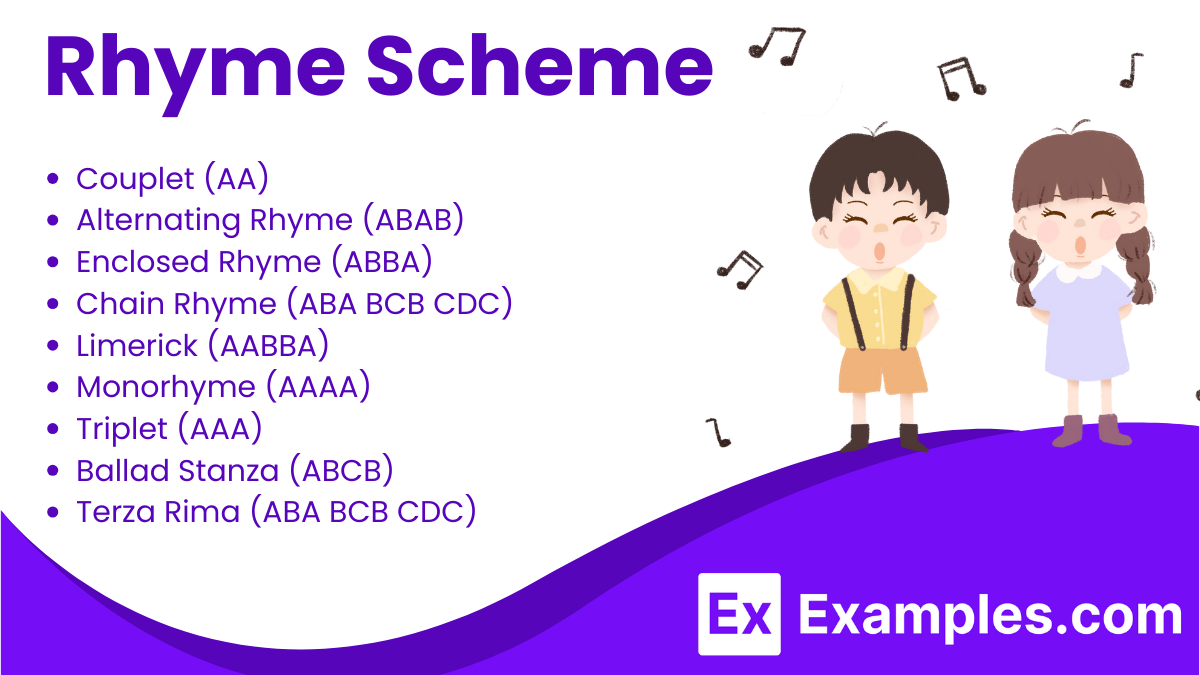40+ Rhyme Scheme Examples
In the realm of poetry, where words metamorphose into intricate works of art, rhyme schemes play a pivotal role in sculpting the melody of verses. A well-executed rhyme scheme can infuse poems with depth, enhancing their impact on the reader’s senses. In this article, we will delve into the world of rhyme schemes, exploring their definition, crafting process, and some illustrative examples to fuel your poetic endeavors.
What is Rhyme Scheme?
The rhyme scheme of a poem or song refers to the pattern of rhymes at the end of each line. It’s usually represented by letters to indicate which lines rhyme; lines designated with the same letter rhyme with each other. For example, a simple four-line poem where the first line rhymes with the third, and the second line rhymes with the fourth, would have an ABAB rhyme scheme.
Types of Rhyme Scheme with Examples
1. Couplet (AA)
- Description: Each pair of lines rhymes with each other.
- Example: Shakespeare’s sonnets often end in a rhyming couplet.
2. Alternating Rhyme (ABAB)
- Description: The first and third lines rhyme with each other, and the second and fourth lines rhyme with each other.
- Example: Much of traditional and folk poetry uses this scheme.
3. Enclosed Rhyme (ABBA)
- Description: The first and fourth lines rhyme with each other, and the second and third lines have their own rhyme.
- Example: Often found in more complex poetic forms like the Italian sonnet.
4. Chain Rhyme (ABA BCB CDC)
- Description: The rhyme from the end of one stanza carries into the beginning of the next.
- Example: This scheme can create a linked, continuous effect across stanzas.
5. Limerick (AABBA)
- Description: A humorous five-line form with a distinctive rhythm, where the first, second, and fifth lines rhyme, and the third and fourth lines form a rhymed couplet but are usually shorter.
- Example: Limericks are often nonsensical or whimsical.
6. Monorhyme (AAAA)
- Description: Every line in the stanza rhymes with each other.
- Example: This can be used for dramatic emphasis or in light, playful poetry.
7. Triplet (AAA)
- Description: All three lines in a stanza or a section of a poem rhyme with each other.
- Example: This scheme can offer a compact and intense rhyming effect.
8. Ballad Stanza (ABCB)
- Description: The second and fourth lines rhyme, while the first and third lines do not. It’s typical of many folk ballads.
- Example: This structure is common in narrative poems and songs.
9. Terza Rima (ABA BCB CDC)
- Description: An interlocking three-line rhyme scheme. It’s sophisticated and was famously used by Dante Alighieri in “The Divine Comedy”.
- Example: This creates a flowing, interconnected poetic texture.
10. Villanelle (ABA ABA ABA ABA ABA ABAA)
- Description: A complex scheme involving five tercets followed by a quatrain, with the first and third lines of the first tercet recurring alternately at the end of each subsequent stanza and then together in the final stanza.
- Example: This form is known for its repetition and intricate rhyme, seen in poems like Dylan Thomas’s “Do not go gentle into that good night”.
| Rhyme Scheme | Description | Example |
|---|---|---|
| ABAB | Alternate lines rhyme. | The second line rhymes with the fourth, while the first rhymes with the third. |
| AABB | Consecutive lines rhyme in pairs. | The first two lines rhyme with each other, as do the next two lines. |
| ABBA | The first and fourth lines rhyme, as do the second and third, creating a sandwich-like pattern. | Common in quatrains. |
| ABCB | Only the second and fourth lines rhyme, leaving the first and third lines unrhymed. | Often used in ballads. |
| ABCABC | A more complex scheme for longer stanzas, with no immediate repetitions. | Varied rhymes throughout. |
| ABAC | Rhymes are interlaced, with the first and third lines rhyming, and the second line rhyming with a line in the next stanza. | Creates a link between stanzas. |
How to Identify Rhyme Scheme?
- Read the Poem: Start by reading the poem aloud. Hearing the poem can make it easier to catch rhymes that might not be as obvious on paper.
- Focus on the Last Words: Pay attention to the last word in each line, as the rhyme scheme is determined by these end sounds.
- Assign Letters to Rhymes: Start with the letter ‘A’ for the end sound of the first line. If the second line rhymes with the first, it also gets an ‘A’. If it doesn’t, assign it the next letter in the alphabet, ‘B’. Continue this process for each line. Lines that rhyme with each other receive the same letter.
- Look for Patterns: Once you’ve assigned letters to all the lines, look at the pattern that emerges. This pattern is the poem’s rhyme scheme.
- Consider Near Rhymes: Keep in mind that some poems use near rhymes (where the end sounds are similar but not identical). Decide whether you want to count these as rhymes depending on the strictness of your analysis.
- Identify the Scheme: Use the letters you’ve assigned to summarize the poem’s rhyme scheme. This might be a simple repeating pattern like AABB or a more complex one like ABABCC.
- Check for Exceptions: Some poems might have a consistent rhyme scheme but include a line or two that deviates. Note these exceptions as they can be significant to the poem’s overall structure or meaning.
- Consider the Poem’s Structure: Some poems, especially longer ones, may have different sections or stanzas with their own distinct rhyme schemes. Identify the scheme for each section separately.
1. Rhyme Scheme Practice Example

schoonschool.files.wordpress.com
2. Rhyme Scheme Poem Example

mpsjodhpur.org
3. Significance of Rhyme Scheme Example

repository.kln.ac.lk
4. Mapping Rhyme Scheme Example
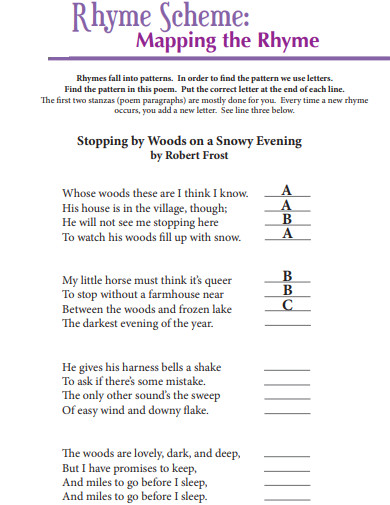
shanahan2.pbworks.com
5. Rhyme Scheme Example

ca02217589.schoolwires.net
6. Christmas Rhyme Scheme Example

teach-english-in-china.co.uk
7. Rhyme Scheme Poetic Form Example

mrwieland.files.wordpress.com
8. Rhyme Scheme Template
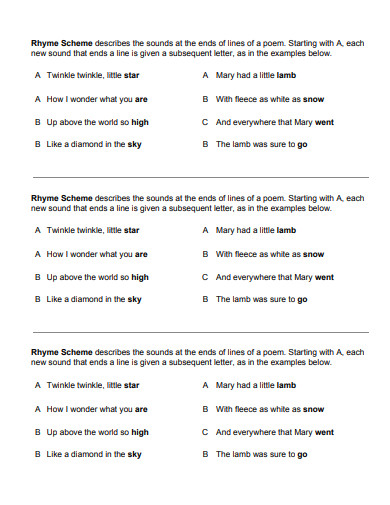
puzzledpint.com
9. New Rhyme Scheme Example

ajssh.leena-luna.co.jp
10. Find Rhyme Scheme Example

gearyschools.org
11. 7th Grade Rhyme Scheme Example

ccadana7.weebly.com
12. Virtual Lesson Rhyme Scheme Example

lexrich5.org
13. Rhyme Scheme Checklist Example

tutorified.com
14. Rhyme Scheme Activity Example

bennington.edu
15. Marking Rhyme Scheme Example

writingmusicaltheatre.com
16. Types of Rhyme Scheme Example

pmt.physicsandmathstutor.com
17. Rhyme Scheme Example

regent.edu
18. Short Rhyme Scheme Example

s3.amazonaws.com
19. aabba Rhyme Scheme Example

sbpsranchi.com
20. Ballad Rhyme Scheme Example

acmgnyr.org
21. Rhyme Scheme Pattern Example
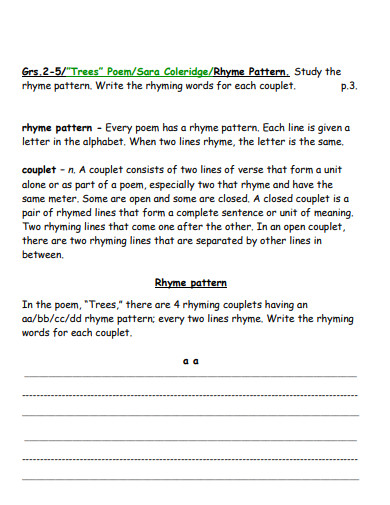
mothergoosecaboose.com
22. Shakespearean Rhyme Scheme Example

dcs.k12.oh.us
23. Class 10 Rhyme Scheme Example

thomas.k12.ga.us
24. Villanelle Rhyme Scheme Example
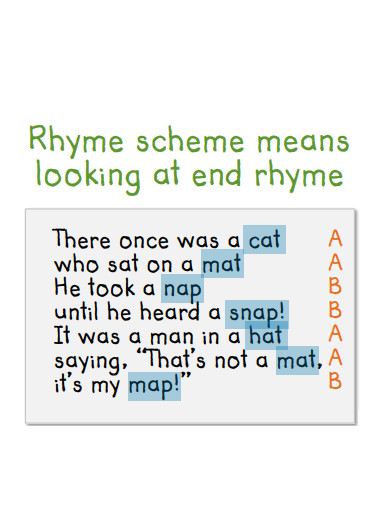
process.fs.learnzillioncdn.com
25. English Rhyme Scheme Example

cmhof.imgix.net
26. Rhyme Scheme Planning Sheet Example

blackhallprimary.files.wordpress.com
27. 14 Line Rhyme Scheme Example

scasd.org
28. Standard Rhyme Scheme Example

apata.com.au
29. Free Rhyme Scheme Example

jhwolfanger.com
What is a Rhyme Scheme?
At its core, a rhyme scheme is a pattern of rhyming words found at the end of lines in a poem. This pattern not only lends a musical quality to the poem but also acts as a unifying thread that guides the reader through the verses. The arrangement of rhymes is denoted using letters, with each unique rhyme sound assigned a different letter of the alphabet. Rhyme schemes can vary widely, from simple and repetitive patterns to intricate and complex arrangements that weave an intricate web of sound.
How to Craft a Rhyme Scheme
To embark on your journey of crafting a captivating rhyme scheme, follow these steps:
Step 1: Choose a Poem Type and Theme
Before diving into the realm of rhyme schemes, select the type of poem you wish to write and identify its theme. Whether it’s a sonnet with strict rules or a free verse poem, understanding the elements and characteristics of the chosen poem type will guide your creative process.
Step 2: Set the Tone and Stanza Structure
Determine the tone you wish to convey through your poem. This will influence your choice of words and the overall mood of the verses. Additionally, decide on the stanza structure – the number of lines per stanza – as this will impact the rhyme scheme’s arrangement.
Step 3: Create Analogies and Imagery
Weave analogies and vivid imagery into your verses to enhance the thematic depth of your poem. Analogies help the reader relate to complex concepts, while imagery paints a visual picture that resonates with their senses, making your poem memorable and engaging.
Step 4: Establish the Rhyme Scheme
Now comes the crux of the matter: establishing your rhyme scheme. Assign a letter to each unique rhyme sound present in your poem. Follow the pattern consistently throughout the poem, ensuring that each line adheres to the rhyme scheme you’ve chosen.
FAQs
What is the most common rhyme scheme?
The most common rhyme scheme is ABAB. This pattern involves alternating lines rhyming with each other (the first line rhymes with the third, and the second with the fourth), creating a pleasing and straightforward rhythmic structure.
How do you identify a rhyme scheme?
To identify a rhyme scheme, examine the end words of each line for rhymes, assigning a new letter (starting with A) to each unique rhyme sound. Lines that rhyme share the same letter, mapping out the pattern throughout the poem.
What songs have the AABA rhyme scheme?
Songs with an AABA rhyme scheme include classics like “Over the Rainbow” from The Wizard of Oz and The Beatles’ “Yesterday.” This structure features two repeating sections, a contrasting bridge, then a return to the initial theme.
What is a AABB poem called?
A poem with an AABB rhyme scheme is often called a couplet when the pairs of rhyming lines are considered independently, but when this pattern extends throughout the entire poem, it may simply be referred to as having an AABB pattern without a specific name.
What does ABCB mean in poetry?
In poetry, ABCB is a rhyme scheme where the second and fourth lines rhyme, while the first and third lines do not, creating a pattern where every other line rhymes. This scheme is common in ballads and narrative poems.
What’s the objective of using a rhyme scheme in a poem?
A rhyme scheme serves multiple purposes. It adds a musical quality to the poem, making it more pleasing to the ear. Additionally, it helps create a sense of unity and structure, guiding the reader through the poem’s flow.
Can I use a cliche in a poem with a rhyme scheme?
While it’s advisable to avoid cliches in your writing, a well-placed cliche within a poem can work if it serves the theme and tone effectively. However, strive to infuse your work with fresh and original language whenever possible.
Can I mix different rhyme schemes within a single poem?
Yes, you can experiment with multiple rhyme schemes within a poem to create dynamic shifts in tone or emphasize specific sections. However, ensure that the transitions between different schemes are smooth and enhance the overall coherence of the poem.
Crafting a compelling rhyme scheme is akin to composing a melodic symphony with words. By understanding the nuances of different rhyme schemes, mastering the steps involved, and infusing your poetic endeavors with creativity, you can create verses that resonate deeply with your readers. As you continue your poetic journey, remember that each rhyme scheme is a unique brushstroke on the canvas of literature, contributing to the rich tapestry of human expression.


